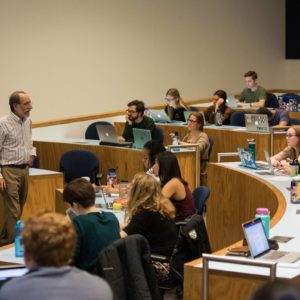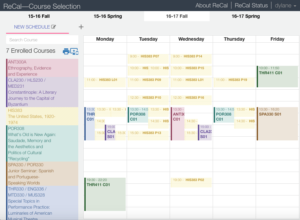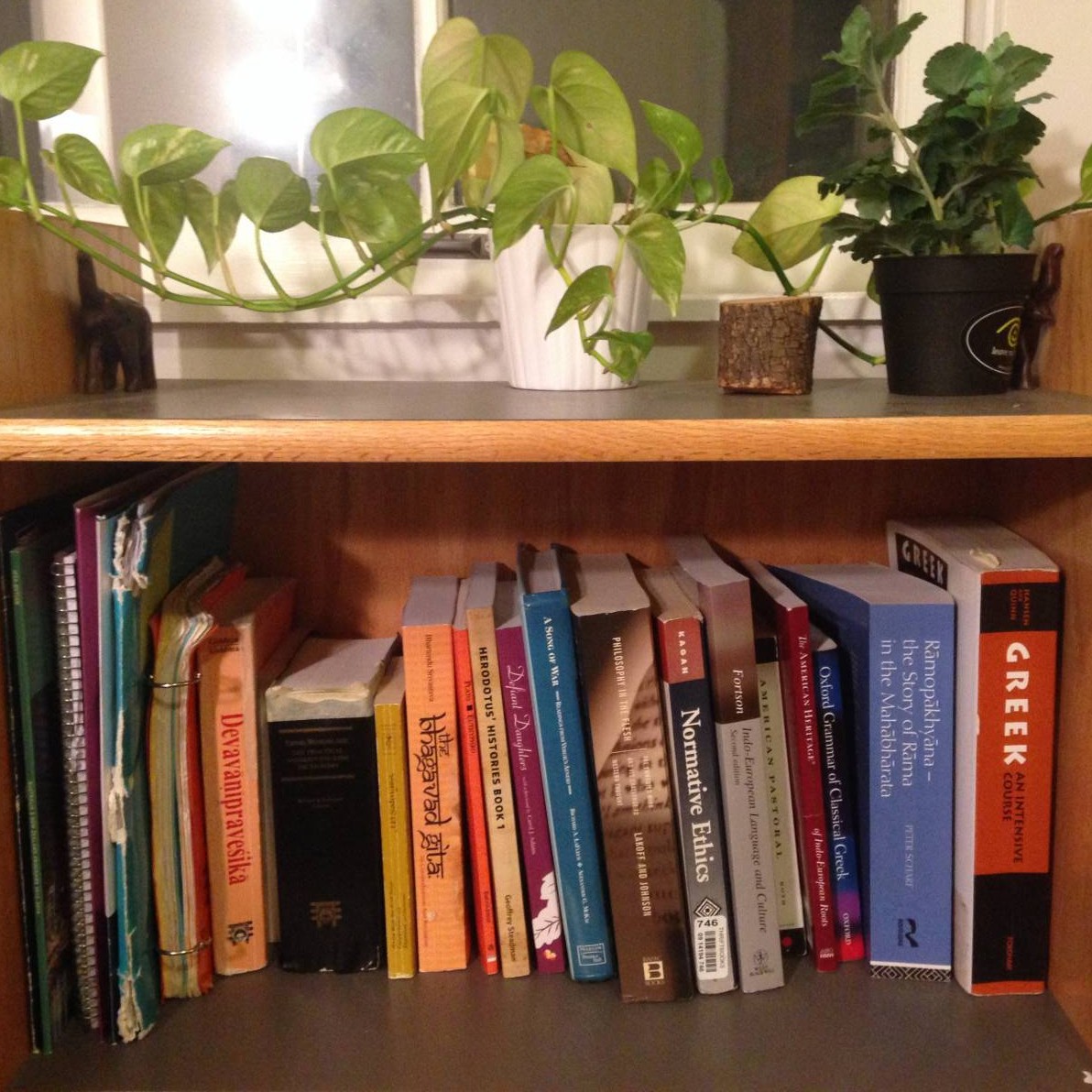Choosing a topic for independent work can be a challenging task. It can be difficult to narrow down the seemingly infinite research topics to one that you find compelling (see my post here with tips on how to do that), and on top of that, you have to juggle your research with coursework that may be unrelated. It isn’t always easy to switch gears between, say, literary criticism and your STL. That said, your coursework need not be totally separate from your independent work, and need not even parallel your independent work at the exact time you are conducting it. With courses for the spring semester just released, I want to suggest ways that you can structure your selections to complement (and even supplement!) your own research. This way, next semester, your own independent work may not actually be so “independent” after all. Continue reading Coursework and Independent Work: Using One to Guide the Other
Mid-semester Reflections: Knowing When to PDF a Class
Last spring, I began the semester specifically planning to PDF my English class. I knew my schedule would be time-consuming, since in addition to English, I was also taking immunology, organic chemistry, intro to material science, and Portuguese. Because I intended to count all of my other courses as either CBE departmental electives or towards a Portuguese certificate, so I thought it would be wisest to PDF English.
However, half-way through the semester, I realized that I was doing relatively well with the English coursework, so I probably did not need to PDF the course. The course that was actually more time-consuming and difficult than I had expected was immunology. This caused me to rethink my process for choosing how to select a course to PDF. I started to look at the course load itself instead of just at the requirements I was satisfying, and in the end, I chose to PDF immunology. In this post, I will discuss in more detail some things I considered before making my decision and offer tips for selecting to PDF a class.

Continue reading Mid-semester Reflections: Knowing When to PDF a Class
How to Select Courses
The registrar for spring courses came out not too long ago. It’s time to start thinking about course selection!
Each semester, Princeton offers over 1,000 courses, taught in over 100 departments and programs, over a range of 8 distributions by professors who have served as Presidents, been awarded Nobel Prizes, made groundbreaking discoveries in their fields, and received Pulitzer Prizes. At Princeton, each course is not just a series of lessons; courses are opportunities–opportunities to travel, to get to know professors, to learn methods for independent work, to explore your interests.
With so much available each semester, how does one pick just 4 or 5 courses to take?
Here is a guide to Princeton’s (many) resources for selecting courses. Included are reviews of different online applications for course searching and scheduling and a few general tips of advice.
GEO/WRI 201: The Best Course on Scientific Research and Writing Offered at Princeton
“Any science major should consider this course…it is basically independent work guided by two top notch professors and supported by an entire seminar class.” – Anonymous Student Review
Every undergraduate studying the natural sciences at Princeton undertakes significant independent research projects in their Junior and Senior years. GEO/WRI 201: Methods in Data Analysis & Scientific Writing is a unique course designed specifically to teach students how to write an independent scientific paper. If you are a Sophomore or Junior looking to attain the concrete skills and confidence to tackle independent research, there is no better class to take.
In 201, you will learn how to design, research, write, and present original scientific research, all through the lens of measuring changing landscapes using satellite and drone-derived aerial imagery. Under the mentorship of Adam Maloof (GEO) and Amanda Irwin Wilkins (WRI), and with the support of your peers, you will: develop an original, well motivated scientific question; design effective field methods to test a specific hypothesis; quantitatively analyze data and imagery; and learn how to effectively communicate the results in a scientific paper and slideshow presentation. The highlight of the class is a nine day field trip across Utah, where students work collaboratively to implement their own field methods, piloting drones and collecting climatological data.

Structuring Senior Year: Choosing Courses
The registrar will soon be releasing fall course offerings. Even as spring semester continues full speed ahead, many juniors are beginning to think about the coming year. Especially for A.B. seniors, who take only six classes, the questions of which to take, how many to take, and how to balance them with a thesis and post-graduation plans, all loom. Remembering how I, as a second semester junior, relied on advice from outgoing seniors, I decided to compile some of my own reflections on approaching coursework in senior year.
Three-three or four-two? For most A.B. students, senior year is the only time we take six courses, rather than eight or nine, to make more time for independent research. We may divide these courses in two ways: three each semester; or four in the first, two in the second. This decision may come down to a number of factors, including: your ability to plan ahead and pace your work, your spring extracurricular conflicts, and your research requirements (for some, scheduling lab work is an important consideration). Personally, I am so grateful for my decision to take four and then two. Especially since I have two theses — one for the Spanish and Portuguese concentration, and a thesis play for the theater certificate — I appreciate the lighter course load.
Final requirements? As you select final courses, narrowing down the choices can seem impossible. Before you make any decisions, first consult your departmental, certificate, and distribution requirements. Many departments have advising tools and calendars to help keep you on track. If you have any prerequisites left, check if these courses are only offered one semester. Senior fall, for instance, was my last opportunity to take ANT 300, a requirement for the Ethnography certificate. Having this in my schedule helped me limit my other choices.

Choosing Classes: Things to Think about & University Resources
Spring courses were recently released on the university registrar, which means it’s time for many of us to start considering some difficult decisions. Choosing the course arrangement that best fits your priorities/schedule is crucial to ensure that you have a fulfilling spring semester.
Over the past four semesters, I’ve used many tips passed on by wise upperclassmen to help choose my own courses. Here are some of the best ones, followed by some resources that are helpful for choosing classes!

Continue reading Choosing Classes: Things to Think about & University Resources

